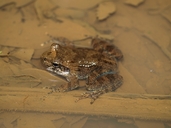|
Description
M 32-41 mm, F 37-46 mm. Closely related and very similar to M. ulcerosus (Glaw and Vences 2007).
Distribution and Habitat
Country distribution from AmphibiaWeb's database: Madagascar
Andapa, Montagne des Français, Ankarana, Montagne d’Ambre (Glaw and Vences 2007). Probably occurs more widely. It has been found between 100-1,100 m asl along streams of evergreen forest and dry forest. It also inhabits degraded habitats, with one specimen found in a ditch within degraded forest near a town (Vences et al. 2008).Life History, Abundance, Activity, and Special Behaviors
Habits: Similar to M. ulcerosus (Glaw and Vences 2007). Breeding takes place in streams (Vences et al. 2008).
Calls: A single, relatively short pulsed note of low intensity (Glaw and Vences 2007).
Trends and Threats
Common. It occurs in one protected area, the Mont d'Ambre National Park. This species can tolerate degraded habitat and appears to be an adaptable species (Vences et al. 2008). Comments
Taken with permission from Glaw and Vences (2007).
References
Glaw, F., and Vences, M. (2007). Field Guide to the Amphibians and Reptiles of Madagascar. Third Edition. Vences and Glaw Verlag, Köln.
Vences, M., Andreone, F., and Glaw, F. (2008). Mantidactylus bellyi. In: IUCN 2008. 2008 IUCN Red List of Threatened Species. www.iucnredlist.org. Downloaded on 29 April 2009.
Originally submitted by: Miguel Vences and Frank Glaw (first posted 2009-04-29)
Edited by: Kellie Whittaker (2009-05-06)Species Account Citation: AmphibiaWeb 2009 Mantidactylus bellyi <https://amphibiaweb.org/species/6764> University of California, Berkeley, CA, USA. Accessed Nov 2, 2024.
Feedback or comments about this page.
Citation: AmphibiaWeb. 2024. <https://amphibiaweb.org> University of California, Berkeley, CA, USA. Accessed 2 Nov 2024.
AmphibiaWeb's policy on data use.
|





 Map of Life
Map of Life